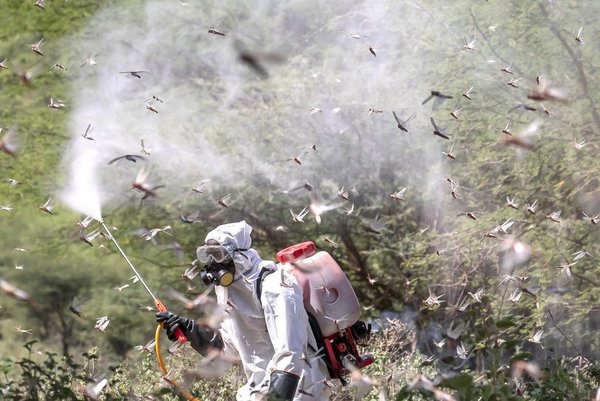- Share this article
- Subscribe to our newsletter
Fighting Desert Locust despite COVID-19 constraints
The Desert Locust upsurge in East Africa continues to remain alarming, the Food and Agriculture Organization (FAO) reported in April 2020. This is particularly the case in Ethiopia, Kenya and Somalia, where it poses an unprecedented threat to food security and livelihoods.
The six East African countries worst affected or at risk of locusts are Ethiopia, Kenya, Somalia, South Sudan, Uganda and Tanzania. Around 20 million people in these countries are already experiencing acute food insecurity, and a further 15 million in Yemen, which is also being affected by the pest.
Dramatic increase in locust numbers over the next month
Widespread rainfall in March is expected to produce a dramatic increase in locust numbers in East Africa over the coming months, with new swarms expected to move from Kenya into South Sudan and Uganda, FAO warns. The situation is also worrying in the Islamic Republic of Iran and Yemen where a new generation of locusts is emerging.
FAO estimates the number of locusts could increase another 20 fold during the upcoming rainy season unless control activities are stepped up. The current situation represents an unprecedented threat to food security and livelihoods that could lead to further suffering, displacement and potential tensions.
Restrictions due to COVID-19 create new challenges
Restrictions on the movement of personnel and equipment imposed by COVID-19 have created challenges, but FAO is continuing to work with national governments, farmers and agricultural producers to contain the outbreak.
But COVID-19 has impacted on the supply of motorised sprayers and pesticides because global air freight has been reduced significantly. A breakdown in pesticide stocks would be dramatic for rural populations whose livelihoods and food security depend on the success of the locust control campaign, experts say.
As COVID-19 restricts the movement of personnel in the field, FAO is intensifying remote data collection. The network of partners, civil society, extension workers and grassroots organizations is critical for providing information from remote locations especially in Ethiopia, Kenya, Somalia and South Sudan.
eLocust3 - a tool to transmit data in real time to national locust centres
FAO is encouraging all countries to use eLocust3, a rugged handheld tablet and app, which records and transmits data in real time via satellite to national locust centres and to the Desert Locust Information Service (DLIS) based at FAO headquarters in Rome.
Since 2015, more than 450 of these handheld devices have been distributed to teams in northern Africa, the Near East and southwest Asia, allowing the transfer of real-time data from the middle of the desert directly to the national locust office and to FAO's headquarters. More recently, FAO has developed a version of eLocust3 that can be used on mobile phones and a GPS device in order to broaden usage and coverage.
(FAO/ile)
Read more at FAO website





Add a comment
Be the First to Comment